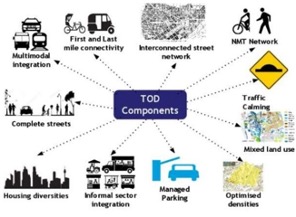Published on: November 19, 2022

Transit-oriented development policy
Transit-oriented development policy

Why in news?
Karnataka government finally approved the Transit Oriented Development (TOD) policy, which aims to boost vertical growth along public transit corridors.
Highlights:
- It is one among the several policy instruments that the state government has to implement as per the Metro Rail Policy.
- The policy seeks to boost the mode share of public transport through increasing the density of population along metro, suburban and other mass transit systems.
What is TOD(Transit-oriented development) Policy ?
- It is urban development of residential, business and entertainment spaces oriented around and within walking distance of public transport like rail, road or air hubs.
- Policy provides an opportunity to leverage the existing and ongoing investments in non-motorized transport (NMT) and public transport (Namma Metro, suburban rail, and bus priority measures) to relook at Bengaluru’s urban form, reimagine spaces and restore Bengaluru’s vibrancy.
What is a TOD Zone?
Core TOD Zone :
- The area within a 6-minute walk to the metro station represents the Core TOD This broadly translates to a distance up to 500 meters from the transit station.
- It is generally amenable to house the highest intensity of transit supportive land uses
Standard TOD Zone:
- The area within a 6- minute cycling distance to the station broadly covers a distance up to 1000m around the station and is amenable for both walking and cycling.
- This zone will also be planned to host transit supportive activities
- Additionally, it is proposed to extend the transit ridership catchment beyond the TOD Zone up to 2 km from the transit station with a properly designed feeder service to achieve accessibility to the transit station within 6 minutes
The Policy Objectives
- Congruence: Achieve high mode share of public transport
- Connected: Provide built environment and associated infrastructure conducive for NammaMetro Trains
- Coherence: Implement mixed-land use that leads to shorter commutes and reduced travel demand
- Equity: Ensure inclusivity for all economic classes, gender, age, and abilities in the design of TOD interventions
- Vibrant : Enable high quality of life through placemaking and sustainable practices
- Effective : Build enabling framework to deliver TOD projects of high-quality
What are positive outcomes of the policy ?
- It is a framework for planning, designing, and transforming urban areas to make the best use of public transport network by orienting appropriate land uses in urban space.
- Revitalizing tool to transform urban core areas through redevelopment and decentralization land uses that create lively sustainable places in greenfield development.
- Successfully implemented TOD projects lead to a vibrant urban space, greatly reduce private vehicle dependency for commuting and lead to an improved quality of life.
- Promoting a diversity mix of uses/ activities/ jobs/ socio-economic groups.
- Creating an interconnected fine grained street network, multimodal integration, feeder services.
- For businesses, the ease of doing business helps them in scaling. Such corridors also create plenty of job opportunities and make the community economically sustainable
- It will serve to reduce car traffic, and household spending on transportation, will promote walk-to- work and cycle-to-work and therefore healthier lifestyles
- On par of environment it lowers pollution, higher foot-traffic for commercial businesses and decreased suburban sprawl
- It also directs the Bangalore Development Authority and other relevant planning authorities to integrate in the master plans the policy and the accompanying development control regulations for the local planning areas
What are the challenges in implementing the policy ?
- In the core city which is zone A, it is a huge challenge because of high densities and high property values.
- The policy pertaining to Bengaluru considers mass transit like Metro but not buses as a means of transpo But buses are a more popular means of commute in Bengaluru.
- In order to provide the right and accessible infrastructure, the government will have to acquire private property which will cost a substantial sum
- Limiting TOD to the city would be a fragmented approach since commute is more regional in nature.
- Bangalore metropolitan region (BMR) which is around 8000 kms comprises of Bengaluru Urban, Bengaluru Rural and Ramnagara – Chennapatna belt
Way forward
- Bengaluru actually needs a mobility plan rather than just TOD. The National Urban Transport Policy emphasises a mobility plan that integrates both land use and transport planning, through TOD.

